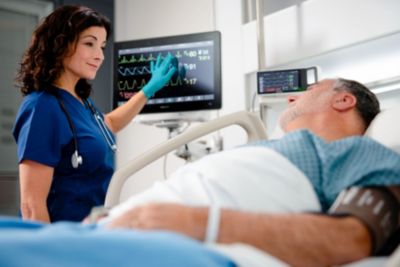
Eight reasons to turn to a modern central monitoring unit (CMU) for telemetry and more
- By Philips
- July 11 2025
- 6 min read
Ongoing healthcare challenges – extraneous alarms, a shortage of experienced nurses, intense scrutiny of outcomes – demand innovations in patient monitoring, including for telemetry. A solution pursued by leading health systems? A new generation of centralized monitoring unit, one providing dependable patient oversight, effective alarm management and valuable frontline support. Top CMUs connect hospitals across the same health system and scale as needed, offering a strong rationale for investing the needed resources. A look at the range of achievable benefits further strengthens their case.
At-a-glance:
- Next-generation CMUs address modern healthcare realities while incorporating flexibility for future innovations and opportunities.
- They do so with transformative designs and tools that support effective workflows, back patient safety and promote consistent care experiences.
- Potential benefits for health systems include better alarm management, additional support for overburdened frontline teams and supplemental oversight that can keep patients safe.

With a range of benefits for health systems, modern CMUs meet the challenges of today and tomorrow
Across the country, the ongoing departure of experienced nurses means a loss of collective knowledge and mentorship on the floor. The frontline nurses that remain are asked to do even more, while continuing to get inundated with alarms – a single patient can generate up to 350 alarms per day [1], of which 85% or more are non-actionable [2].
The potential result? Nurses can feel overwhelmed and unsupported. Critical patient changes can get overlooked, possibly leading not only to near-misses but also serious safety events, including sentinel events.
Modern CMUs provide a solution to these challenges, by connecting with existing information systems, promoting effective alarm management and communication, and providing monitoring flexibility and scalability – particularly when multiple hospitals share a central hub.
Those features support a range of benefits that justify the investment a truly effective CMU requires. A look at eight core benefits:
1. Support standardization and consistency
Uncoordinated remote telemetry monitoring across a health system can lead to variations in care — not just from hospital to hospital but even unit to unit. Differences in how alarms are set, which ones go out to clinicians and how they get escalated can affect patient safety and the experience of receiving care.
Needed standardization and a truly centralized, modern solution go hand in hand – while a shared CMU isn’t required to make changes, it can make the effort more achievable and sustainable. A central hub helps establish a clear framework and chain of command, with the CMU manager ensuring consistent messaging and accountability across connected hospitals.
2. Fill knowledge gaps and promote continued education
Arrhythmias – the focus of telemetry monitoring – are highly complex, variable and potentially debilitating or fatal. Newer nurses may not have the specialized skills or experience to flag heart rhythm changes that are not broadly categorized as acute but may still pose dangers.
CMU teams provide support for overburdened nurses and additional patient oversight. Not only do monitor techs have focused arrhythmia training, but they can also draw on the knowledge of their CMU peers and supervisors. By working in a centralized hub responsible for diverse patient populations, monitor techs see a wide range of arrhythmias to further their expertise.
3. Identify critical patient changes
To help flag patient deterioration, modern CMUs can pull in additional patient insights when needed, from medical records or, at times, other medical devices generating data. Some modern solutions also equip monitor techs with clinical decision support tools to help them identify critical changes that need to go out to care teams. For example, during safety stops, or reviews at set intervals or key moments, CDS tools may help monitor techs check earlier waveforms to ensure nothing was missed.
4. Triage alarms before distribution
The flood of false and nonactionable alarms in today’s hospitals can contribute to alarm fatigue and desensitize nurses to the notifications that matter most. (Nurses can spend 10% or more of their time responding to non-actionable alarms [3].)
With an effective CMU, care teams receive red alarms almost immediately, perhaps after a quick pause for monitor techs to spot and cancel false positives. Inoperative (INOP) alarms for a low battery, a single lead off or a slipped SpO2 probe can also go out automatically, ideally to hospital staff with non-nursing roles.
That leaves yellow alarms, with non-actionable changes mixed in with clinically significant warnings for heart rate, SpO2, non-life-threatening arrhythmias, QT intervals and ST segments. Without additional support, nurses must respond to all yellow alarms by going to the bedside or central station, trips that often prove necessary.
Nurses can spend 10% or more of their time responding to non-actionable alarms [3].
With an effective CMU, monitor techs filter out unnecessary alarms, reducing interruptions for frontline clinicians so they can focus on intentional and meaningful bedside care. By providing relevant and timely information – ideally with the deeper alarm context afforded by some solutions – teams in modern CMUs promote clinical confidence and back patient safety.
5. Secure alarm communications and pathways
With telemetry patients often scattered across hospitals, monitor techs and bedside teams require swift and consistent alarm communication. Modern CMUs address past gaps by promoting standardized procedures and integrating with other hospital systems. As a starting point, they connect to the EMR to pull in staff assignments, sparing time-consuming searches through directories during urgent moments.
Typically, modern CMUs can also incorporate a range of newer clinical communication devices, to avoid calling or paging team members until someone answers. Instead of potentially getting overlooked, critical notifications arrive in a timely manner – ideally to specifically assigned clinicians rather than everyone on duty.
Beyond those capabilities, CMU optimization varies. While many systems automatically escalate unanswered alarms after a set time, some allow hosts to establish pathways based on the type of event. Some provide monitoring with greater visibility into who has – or has not – confirmed alarm receipt and taken action. Some even allow clinicians with smartphones to actively escalate arriving alarms when they’re busy with urgent care duties.
6. Further address alarm management
Alarm customization often comes with a catch: While it may reduce non-actionable notifications to help manage fatigue, newer team members may not feel comfortable making adjustments. Modern CMUs can address this hesitation through innovative tools and workflows that capture alarms data and create a virtuous loop.
The loop starts with nursing supervisors, who can use data to mentor monitor techs about appropriate and safe alarm customization. Monitor techs can then recommend adjusted alarm parameters and settings – based on care area and patient profiles or, more sophisticatedly, by individual patient – for validation and implementation by registered nurses on the floor.
7. Balance technician workloads
When designed properly, a modern CMU combines the census of each connected hospital while establishing flexibility, including the ability to move patient sectors between workstations. Supervisors can balance workloads among monitor techs based not only on number of waveforms watched but also patient acuity, without monitoring gaps or lost data if they need to reassign oversight.
A flexible solution and a standardized approach helps avoid overly taxing cognitive loads for monitor techs. While the “right” patient-to-tech ratio remains unsettled – a 48-to-1 cap has emerged as a possible answer through discussions with experts in the field – workload balancing prevents the extremes and variabilities commonly experienced. It allows health systems to adjust to demand fluctuations and employ variable staffing.
8. Drive improvements with data
Not only can a shared CMU promote standardized assessments across care sites, it can unlock new capabilities for collecting, analyzing and sharing quality data. Health systems can use that data to identify trends and support informed improvements in areas such as protocol adherence, alarm management, telemetry capacity and appropriate use, and staffing and equipment allocation.
In addition to fueling such insights, the ability to capture data can help generate accurate documentation to meet regulatory requirements.
Copy this URLto share this story with your professional network
Sign up for news and updates

Footnotes
- AAMI Foundation HTSI (Healthcare Technology Safety Institute). Using Data to Drive Alarm System Improvement Efforts: The Johns Hopkins Hospital Experience. 2012.
- The Joint Commission. Medical device alarm safety in hospitals. Sentinel Event Alert 50. 2013.
- Philips Healthcare. Just a Nuisance? 2013.
Disclaimer
Results are specific to the institution where they were obtained and may not reflect the results achievable at other institutions. Results in other cases may vary.